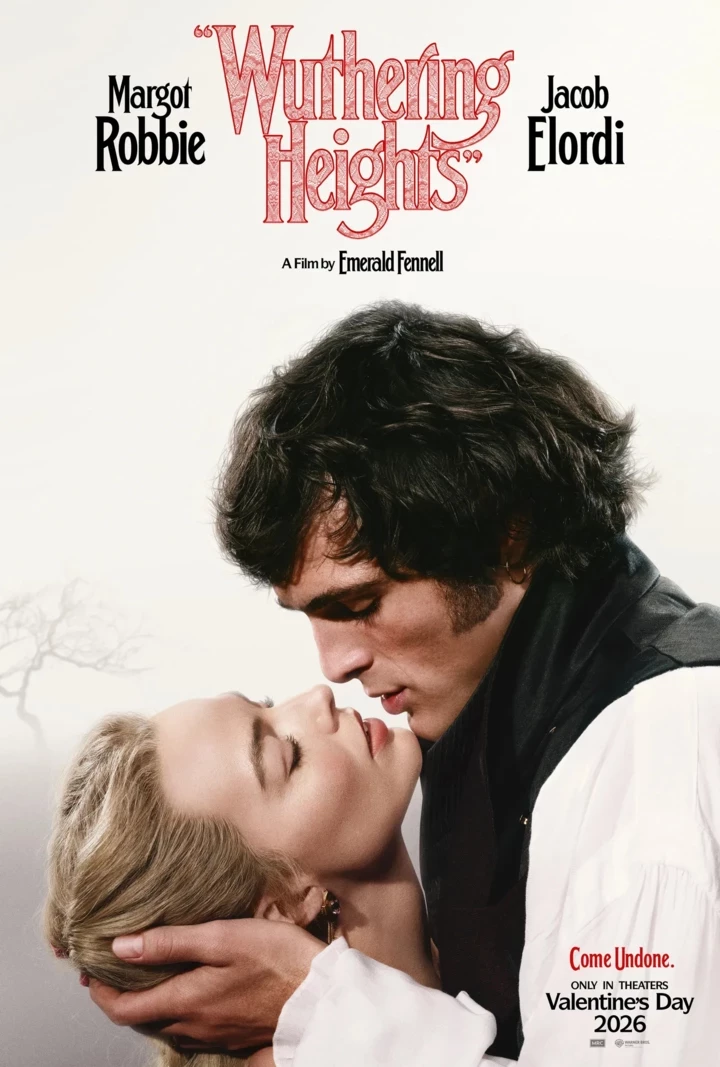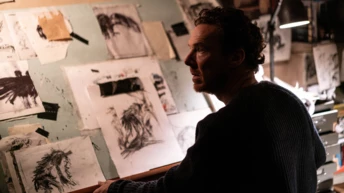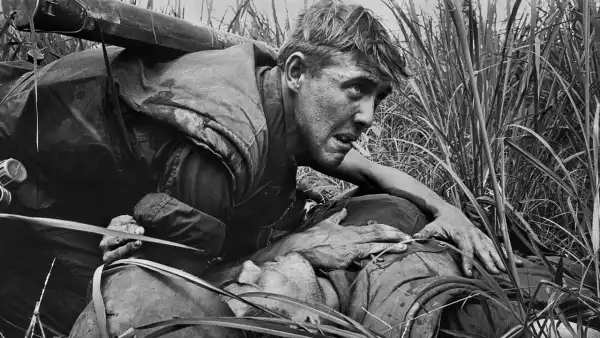
Save this storySave this storySave this storySave this story
In the past, one might have asserted that the Vietnam War was the most documented conflict in history, but that’s no longer accurate, given that almost everyone possesses a camera now. It appears everything is captured on film by somebody. However, circa 1965, the year the U.S. initiated air strikes and deployed ground troops in Vietnam, virtually the sole individuals equipped with cameras were professional documentarians and sightseers. Furthermore, the quantity of tourists in Vietnam dwindled after 1965.
Nevertheless, the count of professional photographers was significant. Roughly six hundred of them journeyed to Southeast Asia during the time of war, attributable to the U.S. military extending a broad invitation to the press to cover the engagement. While not the most imprudent choice the United States enacted in Vietnam, it represented a manifestation of the overarching recklessness rooted in American hubris.
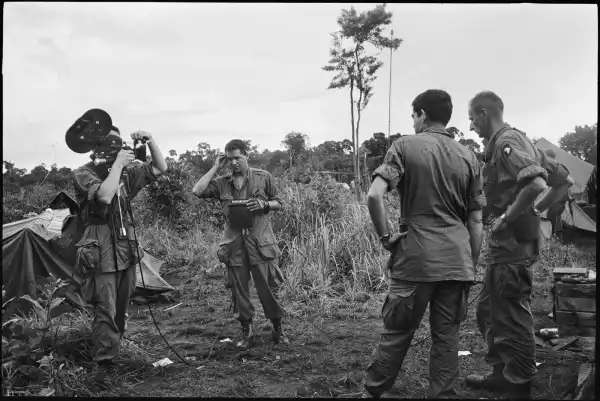
Henry (Hank) Emerson, right, prepares for an interview with Dan Rather, second from right, in early May, 1966.
U.S. authorities might have envisioned that the visuals and narratives disseminated globally through the media would depict valor, but the reality veered in the opposite direction. Warfare transcends the demolition of structures, the primary visual associated with contemporary conflict. War boils down to the act of eliminating individuals. That’s essentially the crux of it. Accordingly, given admission to the battleground, reporters and photographers bore witness to the butchery of non-combatants and the inhumanity inflicted upon detainees, the razing of settlements, and the casualties among soldiers, conveying these sights into the homes of the populace. The press contributed to shifting public sentiment against the war, not from a position of pacifism or political leaning, but rather because war embodies agony, and agony possesses an inherent visual quality.
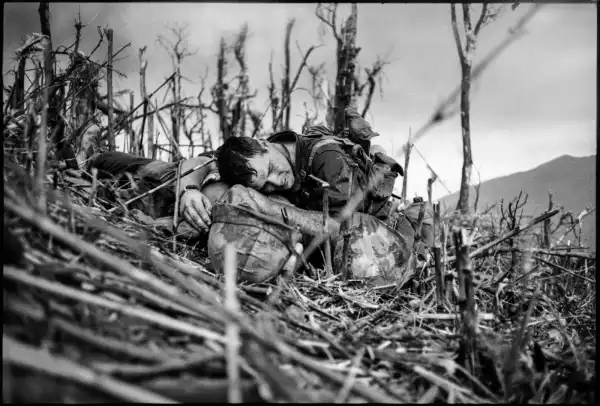
U.S. Navy corpsman Vernon Wilke with a mortally wounded marine, near Khe Sanh, in April, 1967.
Constraints on journalists in Vietnam were minimal. Holding a press credential granted access to military vehicles, transportation via helicopter, lodging on base, shared meals with servicemen, interviews with officers, and the capacity to capture images. Seemingly, openness was the norm. Astoundingly, photographic evidence exists depicting the carnage inflicted upon hundreds of civilians in My Lai village. A combat photographer was embedded with the unit. Albeit a military member, his visual records surfaced once the story broke. Soldiers had evidently grown comfortable with his presence.
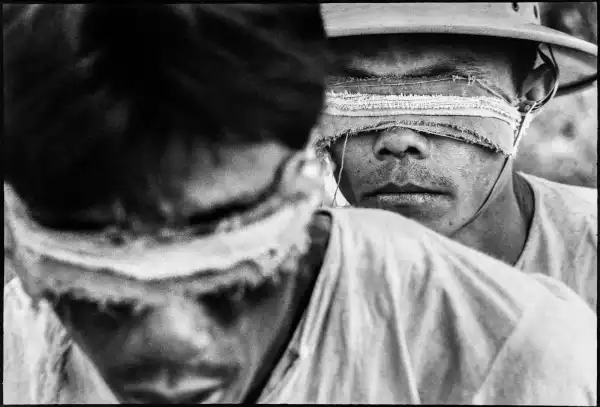
Viet Cong suspects taken away for interrogation, in the Mekong Delta region, in July, 1966.
Photographs from Vietnam found a ready market due to the prevalence of large-format picture publications, including Life, Look, Paris Match, and Stern—characterized by their glossy pages, heavy advertising, and vast readership. Catherine Leroy figured among this readership. Born in a Parisian suburb during 1944, Leroy exhibited traits of a dropout, disliking formal education and finding middle-class existence monotonous. Although employed by a temporary agency, she yearned for thrill. Seeking to impress a romantic partner, she experimented with skydiving, accomplishing eighty-four descents over Burgundy.
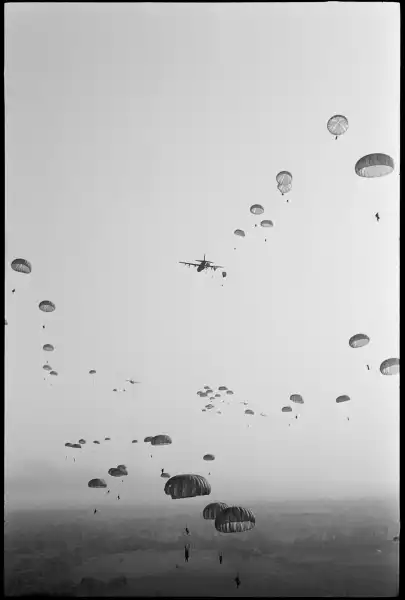
Catherine Leroy photographs her jump in operation, in February, 1967.
Captivated by images in Paris Match, she embraced photography with the recently launched Instamatic camera (circa 1963). With a determination to be at the heart of events, she accrued funds to purchase a Leica and a one-way flight to Saigon. “Photojournalists are my idols,” she expressed, as accounted by writer Elizabeth Becker. “My aspiration is to become a photojournalist. Currently, the foremost narrative globally is the Vietnam War.” She made her arrival in February of 1966, at the young age of twenty-one, possessing limited English proficiency, lacking professional networks, and with scant financial resources. Eventually, she ascended to become among the most esteemed photojournalists covering the war.
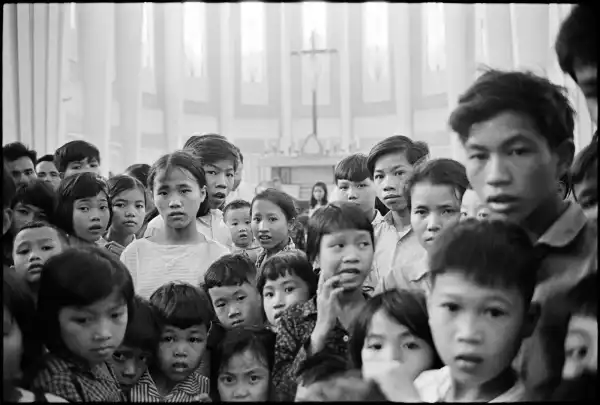
Civilian refugees inside Notre Dame Cathedral at the onset of the Tet Offensive, in February of 1968.
Leroy demonstrated ambition and courage, as affirmed by her acquaintances. She employed harsh language (once mastering the English lexicon) and remained unyielding. She successfully persuaded officials to include her in the solitary paratrooper battle jump of the entire war, earning recognition from the U.S. Army.
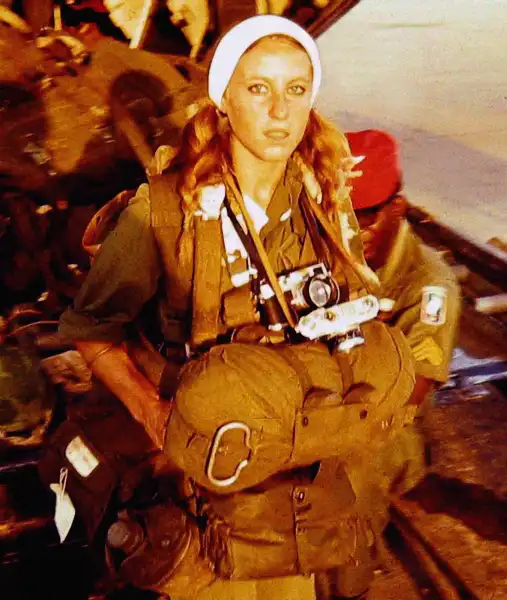
Catherine Leroy before a paratrooper-training jump, in February, 1967.Photograph © Bob Cole / Courtesy Dotation Catherine Leroy
Moreover, frequent mentions are made of her petite stature. Standing at five feet tall, weighing eighty-five pounds, and sporting pigtails, she resembled, as described by an author, “a juvenile male dressed for a masquerade” when adorned in combat attire and boots. She shared dwellings, diets, and routines with the troops. Whenever they surged up a slope, she joined them, burdened with a rucksack and multiple cameras.
“Should your photographs lack impact,” the celebrated war photographer Robert Capa purportedly noted, “it signifies you lack proximity.” Leroy ensured closeness. Instances of soldiers being shot and killed surrounded her. She sustained severe injuries from fragments herself. During the Tet Offensive, she daringly entered the city of Hue using a bicycle, amidst fierce fighting. Detained by North Vietnamese forces, she secured her release by identifying as a French journalist, a strategy that proved successful, and obtained some of the scarce photographs depicting the North Vietnamese Army (distinct from the Viet Cong, who identified as South Vietnamese Communists) accessible to the public. Life magazine featured them prominently as a cover story.
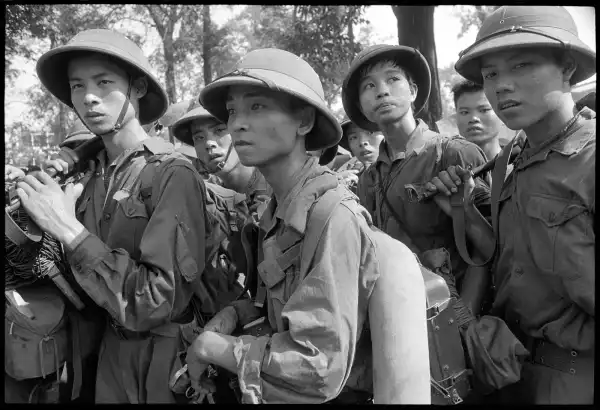
North Vietnamese soldiers approach Saigon at the end of the Vietnam War, in early May, 1975.
Leroy possessed limited familiarity with the region’s past. Certainly, she understood that Vietnam formerly existed as a French possession, which the French relinquished to nationalist movements during the Battle of Dien Bien Phu, back in 1954. Her father shed tears upon hearing the report. Politics, however, held no interest for her. Impartiality defined her presence. She craved the surge of adrenaline.
War photography transpires amidst turmoil and uncertainty, melding serendipity with calculated skill. Securing a photograph necessitates being ill-positioned at an opportune instant, an occurrence nobody anticipates. The result casts a degree of doubt—specifically, what do we perceive? Under what circumstances was the visual generated?—over the genre, chiefly with iconic visuals.
A photograph attains iconic status when separated from its background. Such photographs commonly receive generic labels—exemplified by Robert Capa’s “The Falling Soldier,” from 1936, during the Spanish Civil War. Yet, the soldier’s identity, allegiance, and the photograph’s setting remain obscure. The image inherently provides minimal details. Subsequently, Capa faced accusations of manipulation.
Claims of fabrication in war photography reach as far back as Mathew Brady’s depictions of Civil War battle zones. Brady’s photographic team apparently repositioned corpses to create more aesthetically pleasing compositions. Arguably, the most widely recognized war photograph of World War II was essentially a staged event, namely, Joe Rosenthal’s renowned Iwo Jima visual. Rosenthal was under the employ of the Associated Press. This notable image, taken on February 23, 1945, documents the second flag-raising operation on Mount Suribachi’s peak situated on Iwo Jima island, south of Japan. Since hostilities on the island ceased, the soldiers featured were not in immediate peril, and the flag’s elevation, chronicled on film, unfolded in mere moments. Additional photographers stood by, and the group’s apparent exertion originated from overcrowding. Everyone wished to appear in the shot. Rosenthal dispatched the film to Guam for processing. Subsequently, a member of the A.P. staff picked the image, cropped the view, and broadcasted it around the world through radiotelegraph. It appeared on front pages globally within two days. Rosenthal remained unaware of his accomplishment. He admitted to aiming the camera generally toward the soldiers, without utilizing the viewfinder. He later received a Pulitzer Prize.
One might nearly encapsulate the Vietnam experience via its well-known photographs, visuals readily recognized by all; the war conveyed in abbreviated visual form. Eddie Adams’s “Saigon Execution” dates to February 1, 1968. The shooter is South Vietnamese police commander, Nguyễn Ngọc Loan, and the victim Nguyễn Văn Lém, a Viet Cong militant. Adams, also with the A.P., watched his photograph appear in newspapers around the planet the following day. Assessing its prompt impact on sentiment is challenging; as time went on, the picture grew to symbolize the conviction that U.S. backing of South Vietnam equaled advocating for war offenders. Anecdotes arose asserting Lém’s involvement in the killing of a South Vietnamese officer’s kin, despite vague details. Loan seemingly perceived grounds for summarily executing the prisoner. Adams secured a Pulitzer Prize, predominantly thanks to opportune timing.
“The Terror of War,” alternatively labeled “Napalm Girl,” taken on June 8, 1972, is commonly credited to photographer Huỳnh Công Út. The main character, Phan Thị Kim Phúc, age nine, suffered severe burns over a large area of her body, but managed to live through it. Út, a Vietnamese individual, potentially spared her existence through rapid transportation to a medical center. Nevertheless, the incident did not align with a conventional act of war. Errant South Vietnamese pilots unintentionally showered the children with napalm, erroneously identifying them as Viet Cong amid a fleeing civilian mass. Uncertainty persists surrounding Út’s role as the photographer, despite his consistent affirmation. Reflective of Vietnam, several photographers and reporters were on location—the children fled towards an assembly of journalists. A recent documentary, “The Stringer,” and a piece in the previous summer’s Rolling Stone magazine, present persuasive arguments indicating a freelancer captured the image, being unable to protest Út’s crediting due to A.P. editor assignment. Út received a Pulitzer.
Catherine Leroy’s photographs avoid an air of ambiguity. Her equipment reflects fearlessness. This doesn’t dismiss the prospect of some images attaining symbolic prominence. She wrote fondly and routinely to her family residing in France, allowing us a view into her character beyond the tenacious facade. Also, they clarify her reverence towards the soldiers, many foredoomed, alongside whom she operated. She remarked to her father about potentially detailing “whole pages concerning ‘my Marines.’ Especially impressive are the young marines: composed, deeply relaxed, these tough youths execute professional feats. Exceptional bravery defines elements in these units.”
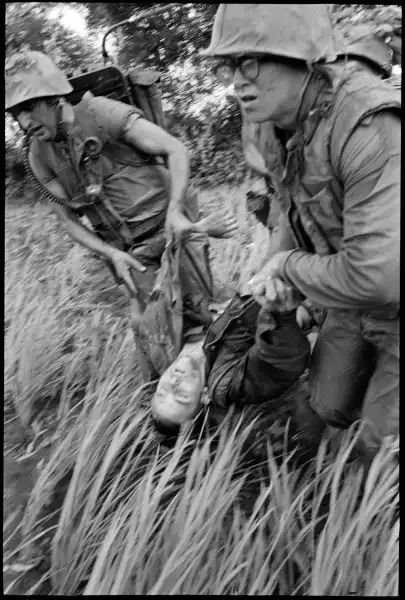
Evacuation of a wounded marine under heavy fire, in October, 1966.
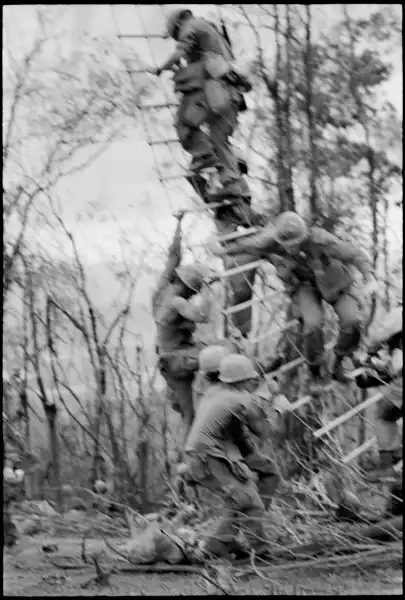
Soldiers on a helicopter ladder, during Operation Thayer II, mid-February, 1967.
Among Leroy’s distinguished Vietnam contributions, “Corpsman in Anguish” emerges, extracted from her sequence illustrating Navy medical attendant, Vernon Wike, tending a dying marine amid the First Battle at Khe Sanh, in 1967. “The images of a Navy corpsman kneeling beside his fallen colleague at 881,” Leroy conveyed, “encapsulate my 15 months within the war—I attained comprehension as to my role in Vietnam.”
Sourse: newyorker.com



